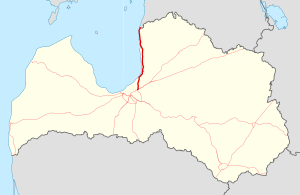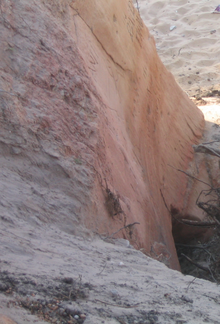Autoceļš A1
| Autoceļš A1 in Latvia | ||||||||||||||||||||||||||||||||||||||||||||||||||||||||||||||||||||||

|
||||||||||||||||||||||||||||||||||||||||||||||||||||||||||||||||||||||
| |
||||||||||||||||||||||||||||||||||||||||||||||||||||||||||||||||||||||
| map | ||||||||||||||||||||||||||||||||||||||||||||||||||||||||||||||||||||||
| Basic data | ||||||||||||||||||||||||||||||||||||||||||||||||||||||||||||||||||||||
| Operator: |
|
|||||||||||||||||||||||||||||||||||||||||||||||||||||||||||||||||||||
| Start of the street: |
Baltezers ( 57 ° 1 ′ N , 24 ° 18 ′ E ) |
|||||||||||||||||||||||||||||||||||||||||||||||||||||||||||||||||||||
| End of street: |
Ainaži ( 57 ° 52 ′ N , 24 ° 23 ′ E ) |
|||||||||||||||||||||||||||||||||||||||||||||||||||||||||||||||||||||
| Overall length: | 101.8 km | |||||||||||||||||||||||||||||||||||||||||||||||||||||||||||||||||||||
| Development condition: | 1 × 2 and 2 × 2 lanes | |||||||||||||||||||||||||||||||||||||||||||||||||||||||||||||||||||||
|
Course of the road
|
||||||||||||||||||||||||||||||||||||||||||||||||||||||||||||||||||||||
Autoceļš A1 is one of Latvia's state highways "State Main Road" ( Lat . Valsts galvenais A utoceļš ). Alternatively, it is called " Riga - Tallinn Chaussee " (Lat. Rīgas-Tallinas šoseja ) or in short as "Tallinn Chaussee" (Lat. Tallinas šoseja ).
The A1 is developed as a motorway-like road . Through an extensive modernization from 2003 to 2007, among other things, the expansion of the 80 km section from Riga to Salacgrīva and the construction of 17 km of local bypass of Saulkrasti included, the top speed to 100 km / could h in the summer and 90 km / h be increased in winter.
As European route 67, the A1 forms the northern part of the Via Baltica within Latvia, which is completely in Vidzeme .
The average traffic volume is 7593 vehicles per day in 2011.
Emergence
Already at the time of the Livs , who had their settlement area east of the Riga Bay , trade routes developed along the coast .
As a result of the construction of the baths along the eastern coast of the Riga Bay, which began at the end of the 18th century , the coastal paths were consistently expanded to become driveways for teams of horses. These routes followed the course of the coast and only avoided swamps or marshes . Due to erosion and coastal erosion , individual sections of the road were shifted further towards the mainland . With the expansion of the towns along the streets and the increasing traffic in the 20th century , bypasses were created . Military considerations led to the further expansion of the street as a highway and to street straightening. Most of this work was completed in the 1960s , when Latvia was part of the Soviet Union . At that time the A 1 was still called "M 12".
In 2006 a comprehensive reconstruction was started with the help of EU funds. From Baltezers, where the crossing of the railway line built in the Soviet Union is changed into an underpass, to Ainaži, the entire A1 was partially widened, partially designed for higher loads. This construction work caused traffic obstructions in some areas due to the fact that only one lane could be used alternately with the help of traffic light control on regularly moving construction sites.
The construction work was worth 46 million Lat (about 65 million euros ), of which 75% was financed by the European Union.
Course of the road
The "A 1" starts about 14 km from Riga city center at the northeastern intersection with the "A 2" and "A 4" at the Riga suburb of Baltezers (German: Weißer See). From there it runs between the Small and the Great White Lake in a northward direction along Adaži. Then she crosses the Gauja .
At Lilaster See she meets the Riga - Skulte railway line , which she now accompanies in a northerly direction.
At the crossing of the Inčupe, the approximately 15 km long passage through the village of Saulkrasti begins with its five formerly independent districts of Inčupe, Pabaži , Pēterupe, Neibāde and Zvejniekciems , which lie along the Baltic Sea coast . The A1 runs through the town a few meters from the Baltic Sea beach, crossing another three rivers. The A1 is only passable at 50 km / h due to the local passage. There are also several traffic lights and pedestrian crossings along this route. In 2006, the construction of an extensive bypass from Lilaste to Skulte, supported by EU funds . This should relieve the place and make the A1 faster.

In Saulkrasti the A 1 meets the junction to the P 6 to Ragana, then crosses the Pēterupe, the Ķīšupe and to the north of Saulkrasti, near Zvejniekciems, the Aģe , in order to leave the Riga administrative district.
Starting from here, the A1 crosses the North Vidzeme Biosphere Reserve at its western limit. This reserve covers the entire area north of the imaginary line from Skulte to Valka .
Via Skulte we continue north through the communities of Skulte and Liepupe , on the southwestern edge of which is Dunte . After crossing the Liepupe , the A1 reaches the junction with the P 11, which leads from Tūja via Limbaži to Kocēni.
After crossing the river Kurlinupe, the road swings in a north-north-west direction. After the Vitrupe has been crossed, the A 1 now leads with separate lanes to Svētciems via the Svētupe . Then the A1 continues without a median to Salacgrīva , where the Salaca is crossed and the P 12 branches off to Limbaži .
From Salacgrīva, the A1 continues north to Ainaži , where the P 15, which leads to Matīši, branches off and then reaches the border with Estonia at the Ikel / Haynasch border crossing .
Attractions
At the beginning of the A1, the route runs between the Kleiner and Großer Weißen See. The special climate in this area had prompted the then Ministry of Health to set up a children's sanatorium here as early as 1956. This sanatorium existed under different names and has been accessible to both children and adults since 2001 as the privately organized rehabilitation center "Baltezers".
The two White Lakes serve as water reservoirs for Riga's water management. In the town of Baltezers there is one of the most important European museums of this kind, the Riga Water Supply Museum (Lat. Rīgas ūdensapgādes muzejs ).
The long route through Saulkrasti leads along dunes lined with spruce and pine trees. Sometimes the direct view of the Baltic Sea leads to carelessness in traffic. For this reason, there are several parking spaces at these locations from where you can enjoy the sea view undisturbed.
In Saulkrasti there is Latvia's only bicycle museum, which shows the history of bicycles from the times of Russia, the Soviet Union and Latvia through a large number of exhibits.
North of Saulkrasti, the road leads past the old Dunte estate , the former seat of the Count of Dunte, where Baron Münchhausen spent five years with his wife Jakobine, née Dunte, and a Munchausen Museum has now been set up. In addition, this museum houses the permanent exhibition "Famous People from Latvian History" of the Latvian Museum of Wax Figures .
From the Tuja / Limbaži intersection to Vitrupe, the distance from the A1 to the Baltic Sea coast is around three to four kilometers. Road exits to the coast offer the possibility of turning towards the west closer to the coast - but then on roads of the 2nd order . Along this route there is a nature reserve with steep walls, caves, niches and several sandstones along the Baltic Sea coast for about 14 km.
Adjacent to this are the "Red Rocks" of Vēczeme. This is long m and about 4 m high to a 200 Sandstone - digestion with caves and grottoes .
The passage through Vitrupe leads across the Vitrupe River, in the east of which there is a forest nature trail that leads to the Kirbiži Forest Museum.
When passing through Svētciems, the A1 crosses the Svētupe River, along which an ancient Livonian cult site is located to the east . These sacrificial caves were one of the longest natural caves in Latvia at 47 m. However, part of the caves has been buried.
With Salacgrīva , the A1 runs through an old fishing town. Here is a museum with an exhibition of old fishing gear. The Chaussee crosses the Salaca in the immediate vicinity of the river mouth into the Baltic Sea . In this flow nor lampreys fences to find. The Salaca river should be ecologically manageable again by 2015 [obsolete] within the framework of the "North Vidzem Biosphere Reserve" programs in the natural river bed up to Mazsalaca . It is also home to the only seafront marina in Vidzeme . The old fisherman's pub "Zum Bootsmann" (Lat. Pie Bocmana ), which was built at the beginning of the 20th century, is located on the local road that runs parallel to the A1 .
On the stretch between Kuiviži and Ainaži there are the Randu Meadows ( lett . Randu pļavas ), a plant protection and bird migration reserve . About a third of all plant species in Latvia can be found on these approximately 200 hectares of coastal meadows.
Right in the town of Ainaži is the Ainaži Seafaring School Museum, which provides information about the history of this Latvian seafaring school and about the construction of sailing ships on the Baltic coast.
Important places along the route
See also
Web links
- Website of the company "Latvian State Roads " (Lat./Engl.)
- The course of the Autoceļš A1 on maps.google.de
Individual evidence
- ↑ Overview of all main streets on lvceli.lv (English)
- ↑ area of Nordvidzemer Biosphere Reserve ( Memento of 27 September 2007 at the Internet Archive )
- ↑ Article about the "Baltezers" rehabilitation center (Russian) ( Memento from June 19, 2012 in the Internet Archive )
- ↑ Rigas Ūdens Rigaer Wasser (Lat.)
- ↑ Pictures from the Museum for Water Supply ( Memento from March 7, 2009 in the Internet Archive )






